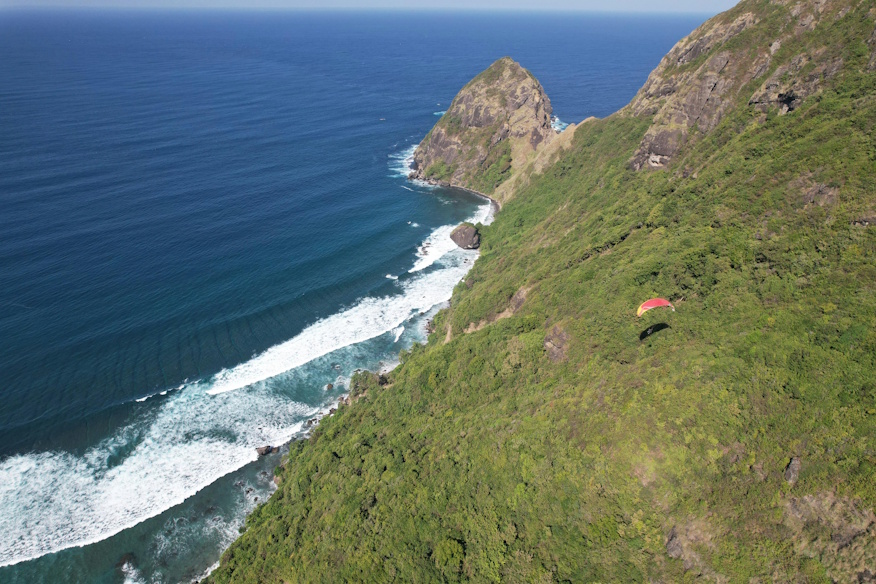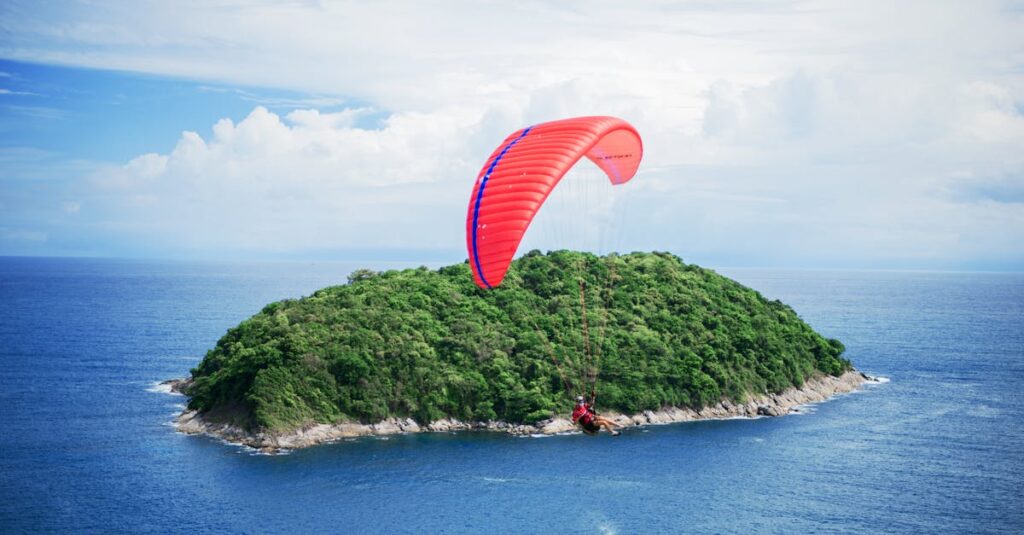What better place to experience paragliding than the breathtaking landscapes of Thailand? Paragliding here offers not just an adrenaline rush but a panoramic view of some of the world’s most stunning scenery: from the lush greenery of the north to the pristine beaches of the south.
Let’s dive into what makes paragliding in Thailand a must-try for thrill-seekers and nature lovers alike.
Key Takeaways
- Diverse locations for paragliding: Thailand offers a variety of scenic locations for paragliding, including the mountains and forests of Chiang Mai and the vibrant coastlines of Pattaya and Phuket, providing unique views and flying experiences tailored for both beginners and experienced gliders.
- Optimal season for flying: the best time for paragliding in Thailand is from November to March, during the dry season, which features stable weather conditions, clear skies, and minimal rainfall, making it ideal for safer and more enjoyable flights. However, it may vary depending on the part of Thailand you’re in.
- Comprehensive safety measures: safety is paramount in Thai paragliding, with strict adherence to local and international regulations, regular maintenance of equipment, and the requirement for pilot certifications to ensure a secure experience for all participants.
- Availability for training and gear rentals: numerous schools and clubs across popular locations offer training sessions for newbies and gear rentals from reputable services, ensuring learners and seasoned gliders have access to high-quality equipment and expert guidance.
- Paragliding tours (tandem): for those looking for an enriched flying experience, it is possible to fly with experienced pilots in various locations.
Overview
Paragliding in Thailand offers an unmatched aerial experience, combining the thrill of flight with the country’s breathtaking landscapes. From the rolling hills of the north to the stunning coastlines of the south, Thailand provides a variety of scenic backdrops for paragliding adventures.
I’ve found that the climate conditions here are mostly favorable for paragliding, with the best months for flying being from November to March when the weather is cool and stable. Please note that this varies from region to region, where Phuket might still be very rainy in November for example, but Pattaya wouldn’t. Several renowned schools and clubs across Thailand offer training sessions and tandem flights, making it accessible for beginners and enhancing skills for seasoned gliders.
Popular spots like Chiang Mai, Pattaya, and Phuket not only host a range of flying sites but also enrich the experience with their vibrant local culture and natural beauty. Each location offers unique views and challenges, from serene high-altitude sails above lush forests to dynamic coastal glides over clear blue waters.
Safety is a paramount concern, and Thailand’s paragliding operators adhere to strict safety protocols. Equipment is regularly maintained and updated, and pilots are certified, ensuring a safe and memorable adventure in the sky. Whether you’re soaring alone or flying tandem, the sense of freedom and exhilaration is a constant companion, as you glide above some of the most stunning landscapes on the planet.
Best locations for paragliding
Chiang Mai: surrounded by mountains and lush forests, Chiang Mai provides gentle winds and scenic views perfect for beginners. Several schools here offer introductory courses where one can learn the basics under expert supervision.
Pattaya: known for its vibrant coastline and less turbulent air currents, Pattaya is another excellent choice for new gliders. The views of the Gulf of Thailand from above are nothing short of spectacular. Certain companies even offer to depart from the nearby island of Koh Lan, providing a fantastic view above the coastline.
Phuket: this may not come through as a paragliding destination, but the various hills, cliffs and the presence of tourists have allowed many companies to settle there. The flights offer incredible views of Nai Harn Beach, turquoise waters, and Andaman Sea cliffs!
Phetchabun, Khao Kho: this site has misty mountains, cool-weather forests, and valleys, where paragliding is used for thermic ridge flying. For this reason, this is a site for intermediate to advanced pilots. It’s less touristy, and has cross country potential.
Krabi, Ao Nang & Railay: these sites offer limited paragliding but still some cliff takeoffs are possible. The views are incredible, with the dramatic limestone cliffs and the turquoise ocean. If you’d like to do a tandem flight, there are a few operators available but it varies seasonally.
Hua Hin, Khao Den: coastal ridge soaring, with scenery including long beaches, golf courses, and sea views. It is a flatland flying with calm coastal winds, making it suitable for beginners and ridge soaring practice.
Each location not only offers ideal conditions but also promises safe and regulated adventures. With schools featuring certified instructors and high-standard equipment, beginners can relish this exhilarating sport without worries.
Here is a short comparison table:
| Location | Type | Best For | Scenery Highlights |
|---|---|---|---|
| Phuket | Hill flying | Scenic tandems | Sea cliffs, beaches |
| Chiang Mai | Mountain | Cross-country, club flying | Jungle, hills, thermals |
| Phetchabun | Ridge/thermal | Advanced, quiet flying | Mountain mist, valleys |
| Krabi | Cliff (limited) | Scenic adventure | Limestone karsts, ocean |
| Hua Hin | Coastal ridge | Beginner practice | Beaches, gentle air |
| Pattaya | Coast | Quick tourist thrill | City & bay views (short ride) |
Best time of year for paragliding in Thailand
In Thailand, the prime months for paragliding span from November to March, when the climate is most favorable. During this period, enthusiasts experience optimal flying conditions that align with Thailand’s dry season, offering clear skies and manageable winds.
Paragliding Conditions And Seasons
Thailand’s tropical climate is divided into three seasons, making certain months better suited for paragliding than others. Here, I detail the various conditions you might encounter:
- Dry Season (November to March): This season is ideal for paragliding due to its minimal rainfall and stable weather. During these months, the northeast monsoon brings cool and dry air, resulting in clear skies and the best visibility conditions. Places like Chiang Mai and Phuket become hotspots for gliders, attracting both novices and seasoned enthusiasts seeking the unparalleled views of Thailand’s landscapes.
- Hot Season (April to June): From April to June, the temperatures rise significantly, often leading to turbulent thermal conditions which can be challenging for paragliding. Despite this, early morning flights might still be possible, especially in coastal areas like Pattaya, where the sea breezes can mitigate some of the heat.
- Rainy Season (July to October): Monsoonal rains characterize these months, creating unpredictable weather patterns and frequently windy conditions. Paragliding during this time is generally not advisable, as the safety risks increase. However, the adventurous few might find windows of opportunity just before or after a rainstorm, when the winds stabilize briefly.
For anyone looking to explore paragliding in Thailand, timing your visit between November and March allows for the smoothest and most enjoyable experience. Remember to check local forecasts and consult with experienced instructors to ensure maximum safety and enjoyment.
Safety Tips For paragliding In thailand
Exploring the skies of Thailand through paragliding can be a transformative experience. To ensure that these moments are not only exhilarating but also safe, adhering to specific safety measures and regulations is essential.
Understanding Local Regulations
In Thailand, paragliding regulations are stringent to maintain high safety standards. Rules vary by region, but here are several consistent points across all locales:
- Certification Requirement: All paragliding pilots must have certification from recognized authorities. This includes both local and international certification bodies such as the Thai Paragliding Association or the United States Hang Gliding and Paragliding Association.
- Permit Essentials: Pilots need a permit to fly at designated sites. Operators typically manage this documentation, but it’s prudent for every paraglider to be aware of the permit status.
- Restricted Zones: Some areas, especially near military bases or within national park boundaries, are off-limits for paragliding. Check local guidelines to avoid violating airspace regulations.
Staying Safe On The Water
Despite Thailand’s beaches being picturesque launch spots, they pose unique safety challenges for paragliders:
- Weather Watch: Always check the local weather conditions before taking off. Coastal areas may experience sudden wind shifts, which can dramatically affect flying conditions.
- Tidal Awareness: Understand the tide schedules and current strengths, especially when launching from or landing on beaches.
- Emergency Procedures: Ensure you’re equipped with marine safety gear like life vests, and know how to perform water landings safely. Practice these maneuvers under the guidance of a certified instructor before attempting water-based flights.
By maintaining awareness of these guidelines and preparing adequately, I guarantee my paragliding adventures in Thailand are not only memorable but also secure.
Conclusion
Paragliding in Thailand offers an unmatched blend of natural beauty and adventure that’s hard to resist. Whether you’re a seasoned glider or a curious beginner the landscapes from Chiang Mai’s mountains to Pattaya’s vibrant shores provide a breathtaking backdrop for your flight. With the best flying conditions from November to March you’ll find Thailand’s skies welcoming and its people even more so. Don’t forget to choose reputable operators and gear up with the top-notch equipment available locally for a safe journey above the stunning Thai scenery. So why wait? The skies over Thailand are calling!
If you’re travelling there next, check out our guide to paragliding in Vietnam, Cambodia and Bali Indonesia!


